
* Having had success with the Gulfstream I through IV, from the 1990s Gulfstream enhanced the product line -- first with the "Gulfstream V" and its refined "G550" variant, and then the "G650", "G700", "G800", "G500", "G600", and "G400". This chapter covers 21st-century Gulfstream business jets.
* In the early 1990s, Gulfstream decided to match the competition from the Bombardier Global Express business jet, and so developed the Gulfstream IV into, of course, the "Gulfstream V" AKA "GV", with initial flight of a prototype on 28 November 1995 -- there were four flight prototypes and a static-test airframe -- and service entry in 1997. It retained the same general configuration as the Gulfstream IV, being a machine built primarily of aircraft aluminum alloy, with:
However, it was enhanced in a number of ways:
The US military adopted it as the "C-37A", which obtained it in numbers. One GV each was obtained by the US Federal Bureau of Investigation and the Federal Emergency Management Agency for VIP-utility use. GVs were obtained by several countries for the VIP-utility role, including Algeria, Greece, Kuwait, and Saudi Arabia.

NASA obtained one GV as a personnel transport and research platform. One GV was obtained by the US National Center for Atmospheric Research (NCAR) in Boulder, Colorado, as an environmental research platform, designated the "High-performance, Instrumented Airborne Platform For Environmental Research (HIAPER)". It was selected on the basis of its general utility and quality, with its high ceiling being useful for atmospheric research.
___________________________________________________________________
GULFSTREAM V:
___________________________________________________________________
wingspan:
28.48 meters (93 feet 5 inches)
wing area:
105.6 sq_meters (1,127 sq_feet)
length:
29.4 meters (96 feet 5 inches)
height:
8.18 meters (26 feet 10 inches)
empty weight:
20,955 kilograms (46,200 pounds)
max take-off weight:
41,050 kilograms (90,500 pounds)
max cruise speed:
935 KPH (580 MPH / 505 KT)
normal cruise speed:
880 KPH (545 MPH / 475 KT)
service ceiling:
16,000 meters (51,000 feet)
range:
10,185 kilometers (6,325 miles / 5,500 NMI)
___________________________________________________________________
* The GV was followed by the "Model GV-SP", better known as the "Gulfstream 550" or "G550", with certification in 2003. It replaced the GV in production, after the manufacture of 193 GVs. It had the same airframe as the GV, but with a new glass cockpit, aerodynamic tweaks, the main entry door moved forward, and new engines: Rolls-Royce BR710 C4-11 turbofans, with 68.4 kN (6,975 kgp / 15,385 lbf) thrust each, and improved fuel efficiency.
The G550 was followed in turn, in 2004, by the "G500" -- which was the same, except for reduced fuel supply. The G500 also introduced new options to the line, including a head-up display, and "Enhanced Vision System (EVS)", using an infrared imager, for night and bad weather.
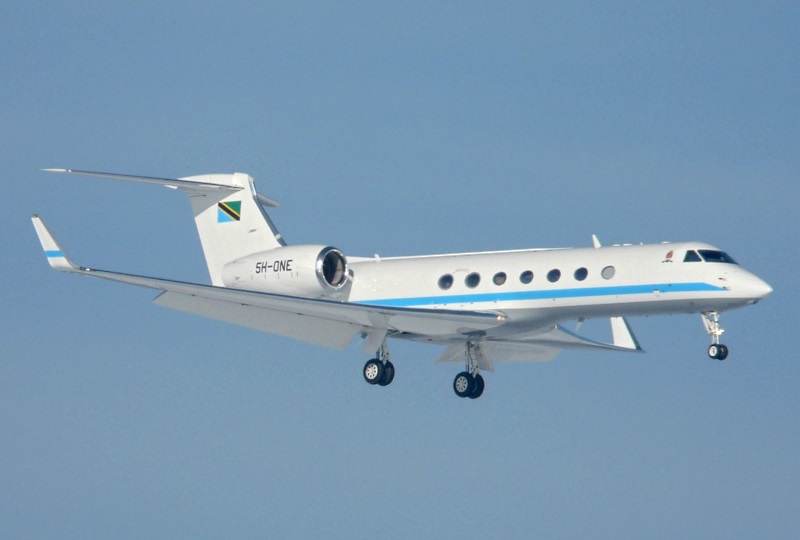
The US military obtained the G550 as the "C-37B" for the VIP transport role. The Gulfstream 550 has been flown in small numbers as VIP transports by the governments of Kuwait, Poland, Sweden, Tanzania, and Uganda. Turkey flies two as "command & control" aircraft, of unknown configuration; they may be military VIP transports, with an enhanced communications suite. The German DLR aerospace organization obtained a G550 as an atmospheric studies aircraft, named the "High Altitude & Long Range (HALO) Research Aircraft". Externally, it looked like a stock aircraft, except for a long striped nose probe.
The G500 was a dud, with only nine produced to end of production; Gulfstream was inclined to pretend it never happened. The last commercial G550 machines were delivered in 2021, at which time over 600 had been sold. Militarized G550 special-mission machines are still being sold, as discussed below. It is not clear if the production line remains open, or if airframes were set aside for military use before shutdown.
BACK_TO_TOP* The Gulfstream V continued, indeed enhanced, the Gulfstream tradition of business-jet sales for military special missions. Following the introduction of the GV, General Dynamics developed a concept for an "EC-37 Special Missions Aircraft (SMA)" based on it. The focus for the EC-37 was the electronics warfare mission, envisioning an aircraft with accommodations for 12 to 15 battle staff and EW operators, with payloads stowed in blisters or attached to underwing pylons.
A "notional configuration" of the EC-37 showed it with a pod mounted on top of the tail to house a wideband satellite data communications link; a canoe fairing under the forward fuselage for signals intelligence (SIGINT) gear, to perform eavesdropping and direction finding; and six detachable pods carried under the wings, possibilities including:
While that was likely a more diverse payload than would be carried on typical operational missions, the idea of carrying SIGINT and jammer gear on the same flight was practical. Using fast digital control systems, the jammer systems could be switched off for a few milliseconds, allowing the SIGINT gear to spot a target, and then the jammer systems would be turned back on to electronically attack the new target. The technique is called "looking through".
General Dynamics also investigated integration of an active-array multipurpose EW system, either built into the fuselage or into the 1.8-meter (6-foot) tall winglets at the tips of the Gulfstream V's wings. In addition, they suggested that the EC-37 SMA could be used as an auxiliary GPS navigation signal source to help defeat GPS jamming and enhance GPS target location. The EC-37 SMA notional configuration did not include armament, but there was interest in carriage of long-range precision strike munitions, allowing the EW aircraft to not only identify and locate targets, but to attack and destroy them as well.
* The EC-37 concept simply outlined possibilities, not a specific configuration, and actual implementations of GV-based SMAs varied widely. The first GVs to be adapted to special missions were two sold to the Japanese Self-Defense Forces in 2001 as "Sea Watch" coastal patrol / search and rescue aircraft, being named "Umi Washi (Sea Eagle)". They were fitted out by Fokker Systems of the Netherlands with a Thales search radar in a neat canoe fairing in the belly forward of the wing, as well as a forward-looking infrared (FLIR) imager that extended from the fairing.
Japanese radios were installed by Murabeni, Gulfstream's Japanese agent and prime contractor for the project, after the aircraft were delivered to Japan. They had two mission consoles, one for the sensor systems operator and the other for the communications system operator; they retained 19 airliner-type seats for use as personnel transports, and had a medevac litter and a galley in the rear cabin. The aft baggage door could be opened in flight to drop a life raft.
The Israelis proved very enthusiastic about the Gulfstream V as a special-mission platform. From 2001, the Israelis began to obtain Gulfstream 550s for conversion into special-mission aircraft by Israel Aerospace Industries (IAI). The first to be introduced was the "Model ELW-2085", known as "Eitam (Sea Eagle)" to the Israeli Air Force (IAF). It was a "Conformal Airborne Early Warning & Control (Conformal AEW&C)" platform -- a highly mutated version of the G550, fitted with an Elta EL/I-3001 Phalcon phased-array radar, with antenna fairings on nose, tail, and on both sides of the fuselage to provide 360-degree coverage. The fairings were actually designed and installed by Gulfstream, working with Lockheed Martin, being provided as part of the Israeli contract.
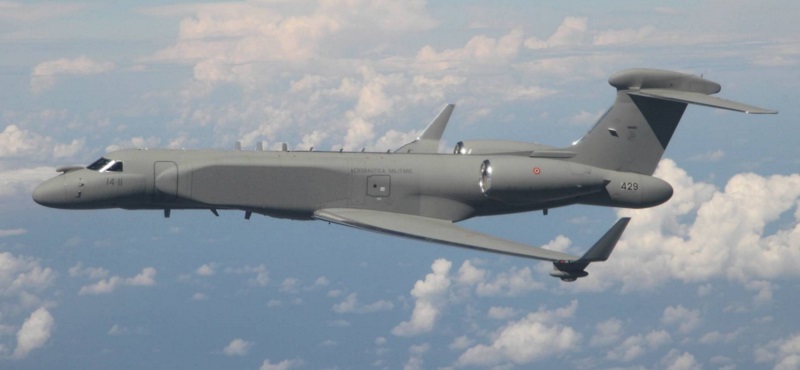
There were electronic support measures (ESM) antennas on wingtips, to locate and categorize radio emitters, plus another fairing on top of the tailfin, and an extensive farm of blade antennas on the top and bottom of the fuselage. It could accommodate from two to six mission specialists, with a line-of-sight (LOS) or beyond line-of-sight (BLOS) satellite communications (satcom) datalink to provide intelligence to ground systems.
The second variant to be introduced was the "Model ELI-3001", known as the "Shavit (Comet)" to the IAF. It was an "Airborne Integrated Signals Intelligence System (AISIS)" for SIGINT gathering and analysis. It had a litter of blade antennas on top of the fuselage and under the wings, plus a large fairing under the fuselage. The Shavit could carry up to 12 mission specialists, with line-of-sight and satcom datalinks to ground stations. Accommodations could be easily shifted around to permit the aircraft to be used as a flying command post.
The third was the "Model ELI-3150", which was a "Multi-Mission Airborne Reconnaissance & Surveillance System (MARS2)", known as "Oron (Stableman)". It used a CAEW airframe, being fitted an active-array radar for surface surveillance, providing SAR-MTI capabilities, and an EO-IR turret in an underwing pod; it appears a long-range optical (LOROP) imager system and SIGINT system could be carried as well. Confusingly, IAI has also offered an "ELI-3150 Intelligence, Surveillance, Target Acquisition, and Reconnaissance (ISTAR)" system, based on the Bombardier Global 6500.
All three variants were fitted with defensive countermeasures systems. It appears the Israelis obtained two Eitam CAEW, three Shavit SIGINT, and one Oron MARS2 machines. Italy has obtained two CAEW machines, designated "E-550A", while Singapore obtained four, which were delivered in 2008. Singapore also obtained an additional G550 as a trainer for the CAEW mission. A maritime patrol system designated "ELI-3360" has also been promoted, and IAI has even considered an inflight-refueling tanker configuration, with a centerline boom or hose-drogue refueling unit.
* In 2018, the US Naval Air Systems Command (NAVAIR) obtained a Gulfstream 550 in CAEW configuration, designated "NC-37B". However, instead of being intended as an AEW aircraft, it was configured by Raytheon as a "telemetry range support aircraft (TRSA)" for the Point Mugu Sea Range off California. The new aircraft was needed by the US Naval Air Warfare Center Weapons Division stems to replace an elderly Lockheed NP-3D Orion TRSA flown in the missile range support role.
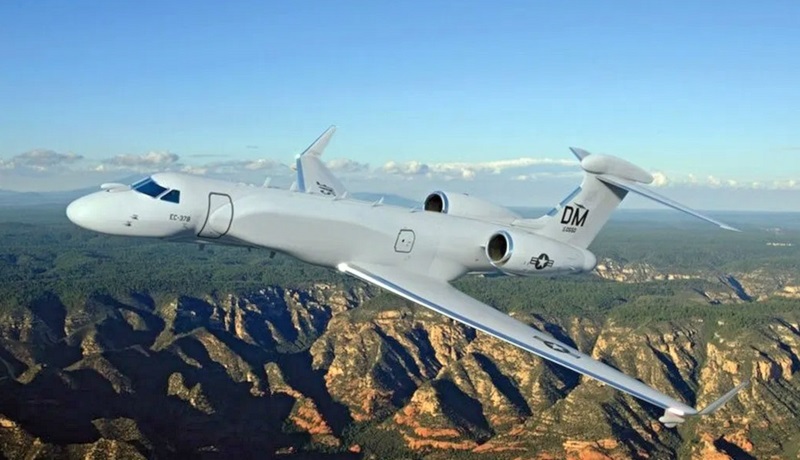
In 2017, the USAF awarded a contract to built ten "EC-37B Compass Call" electronic warfare (EW) aircraft, also based on the CAEW airframe. They were to replace the EC-130H Compass Call aircraft, based on the Lockheed Hercules turboprop transport, in that role. Its operational system will be based on the "Small Adaptive Bank of Electronic Resources (SABER)" system, featuring a set of reprogrammable radios. The first EC-37B went into Air Force service in 2023.
In 2019, Australia ordered four G550s, with another one possible, as EW platforms, to be designated "MC-55A Peregrine". They are to be converted by L3 Systems in the USA. The MC-55As will feature a canoe fairing under the forward fuselage, a satcom antenna in a top fairing, a SIGINT receiver fairing on top of the tailfin, and an electro-optic / infrared (EO-IR) turret in a tail fairing.
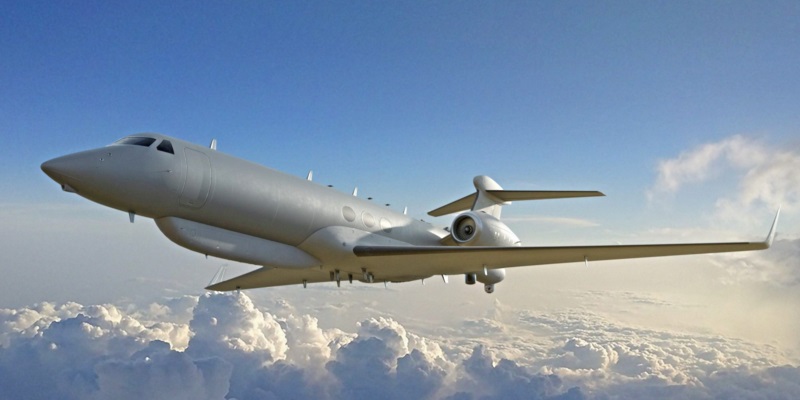
In late 2020, Italy obtained "special mission kits" to modify two G550s to an "Airborne Intelligence, Surveillance, Reconnaissance, & Electronic Warfare (AISREW)" configuration. Details are not clear, but it appears they will be similar to the MC-55A, with a Leonardo Osprey active-array radar, an electro-optic / infrared (EO-IR) imaging system, SIGINT gear, military communications including datalinks, identification friend-or-foe transponder, and defensive countermeasures systems. Apparently, these two aircraft were the start of a batch of eight machines, to be rebuilt into various special-mission configurations.
Gulfstream has promoted a variation on the Gulfstream V special mission concept, in the form of a Gulfstream G550 configured as a drone. Stripped of all the niceties required for carrying people, it would have a load capacity of 9,525 kilograms (21,000 pounds). The "GV-UAV (Uncrewed Aerial Vehicle)" concept, to give it a name, was pitched as a solution for the US Navy's need for a replacement for the EP-3 Aries SIGINT aircraft, as well as the Navy BAMS requirement. It could also be used as a tanker, either with dedicated refueling gear or fitted with buddy refueling packs on its stores pylons. For the moment, the GV-UAV remains a speculative concept, though the Israelis have made noises about a drone CAEW machine.
BACK_TO_TOP* In 2005, Gulfstream began a program to develop a new business jet, announcing the "G650" to the public in 2008 as Gulfstream's "largest, fastest and most expensive business jet". It is an indication of the social status of a Gulfstream that "most expensive" was a selling point. Initial flight of the first prototype was on 25 November 2009; one of the prototypes was lost in a crash in 2011. Certification and introduction to service was in 2012.
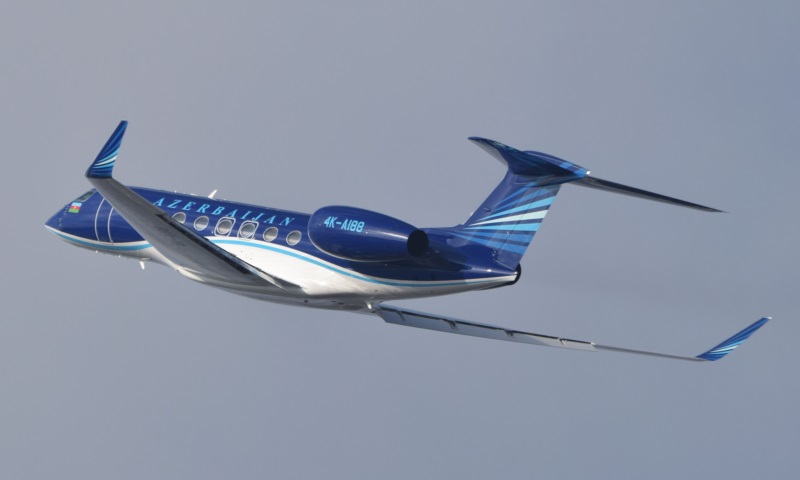
The G650 had the same general configuration as the GV; Gulfstream, having settled on a pattern, has not been inclined to alter it. Changes included:
Although maximum seating is given as 18 passengers, typical luxury configurations appear to be in the range of 8 to 12. The G650 introduced emergency exits, two per side over each wing; although that might seem like excess given the limited passenger capacity, presumably the zoned cabin scheme made it seem more necessary. Later Gulfstream variants would all have the emergency exits.

___________________________________________________________________
GULFSTREAM G650:
___________________________________________________________________
wingspan:
30.41 meters (99 feet 7 inches)
wing area:
119.2 sq_meters (1,283 sq_feet)
length:
30.41 meters (99 feet 9 inches)
height:
7.72 meters (25 feet 4 inches)
equipped empty weight:
24,495 kilograms (54,000 pounds)
max take-off weight:
45,180 kilograms (99,600 pounds)
max cruise speed:
955 KPH (595 MPH / 515 KT)
normal cruise speed:
905 KPH (560 MPH / 490 KT)
service ceiling:
15,545 meters (51,000 feet)
range:
12,965 kilometers (8,050 miles / 7,000 NMI)
___________________________________________________________________
A "G650ER" with extended range was introduced in 2014, with additional fuel tankage in the wings. Fuel capacity was increased by 9%, MTO weight was increased by 4%, while range was increased by about 925 kilometers (575 miles / 500 NMI). One of the development machines flew nonstop from Los Angeles, California, to Melbourne, Australia in 2014, with a record flight (in class) in 2015 for a flight from Singapore to Las Vegas. Over 500 G650s of all variants have been delivered to date.

* The "G700" was announced in 2019, this variant being a 3-meter (10-foot) stretch of the G650ER, powered by Rolls-Royce Pearl 700 turbofans with 81.2 kN (8,275 kgp / 18,250 lbf) thrust each. It featured new winglets, with a greater outward cant, plus more fuel capacity, plus features introduced on the G500:
Initial flight of the G700 was on 14 February 2020, with first deliveries later in the year. Over 30 have been built to date.
___________________________________________________________________
GULFSTREAM G700:
___________________________________________________________________
wingspan:
31.39 meters (103 feet)
wing area:
119.2 sq_meters (1,283 sq_feet)
length:
33.48 meters (109 feet 10 inches)
height:
7.75 meters (25 feet 5 inches)
equipped empty weight:
24,565 kilograms (56,365 pounds)
max take-off weight:
48,805 kilograms (107,600 pounds)
max cruise speed:
955 KPH (595 MPH / 515 KT)
normal cruise speed:
905 KPH (560 MPH / 490 KT)
service ceiling:
15,545 meters (51,000 feet)
range:
13,890 kilometers (8,625 miles / 7,500 NMI)
___________________________________________________________________
The new winglets increased span by 1.04 meters (3 feet 5 inches). The fuselage stretch made room for a fourth living area in the main cabin, along with a bigger forward galley and aft lavatory. Two cabin windows were added, to give ten on a side, a total of 20. It notably introduced programmable LED lighting that could simulate dusk / dawn cycles. The G700 is almost big enough to qualify as a regional airliner, though it is unlikely anyone will buy it to cram it full of Economy seats.
* The Gulfstream "G800" was announced in 2021. It was effectively a G650ER with G700 flight surfaces -- the G800 being 3 meters (10 feet) shorter than the G700 -- being intended to eventually replace the G650ER. It will also be powered by Rolls-Royce Pearl 700 turbofans. It will be able to carry four crew and eight passengers 14,810 kilometers (9,200 miles / 8,000 NMI) at Mach 0.85. Max passenger capacity will be 19 seats. As with the G700 and G800, it will have the Symmetry flight deck and Data Concentration Network. Flight tests began in 2022, with deliveries from 2024.
BACK_TO_TOP* Following the Gulfstream G650, the company decided to come up with improved replacements for the earlier G450 and the G550 -- resulting in the "G500" and "G600" respectively, leveraging off of G650 technology. The G500 recycled the designation of the unsuccessful reduced-range G550. First flight of a G500 was on 18 May 2015, with introduction to service in 2018; first flight of a G600 was on 17 December 2016, with introduction to service in 2019.

The overall configuration of the G500 was much like that of the G650; the G500 was more or less a scaled-down G650. The wing configuration was derived from and configurationally like that of the G650. The G500 was powered by Pratt & Whitney Canada (PWC) PW800 turbofans -- specifically PW814GA turbofans with 67.3 kN (6,870 kgp / 15,144 lbf) thrust each, The cabin dimensions were greater than those of the Gulfstream 550, but not as big as those of the Gulfstream 650: 1.93 meters (6 feet 4 inches) in height and 2.41 meters (7 feet 11 inches) in width. There were seven passenger windows on each side. The G500 introduced the Symmetry flight deck and GE Data Concentration Network.
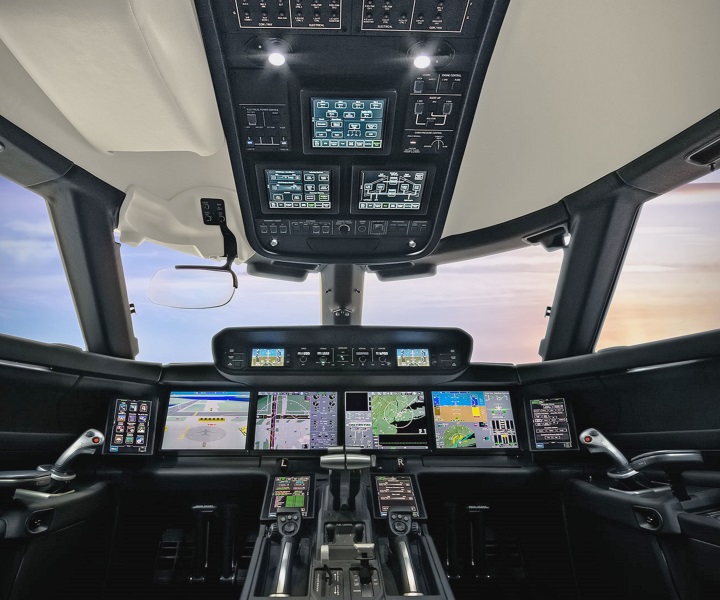
___________________________________________________________________
GULFSTREAM G500:
___________________________________________________________________
wingspan:
26.55 meters (87 feet 1 inch)
length:
27.78 meters (91 feet 2 inches)
height:
7.78 meters (25 feet 6 inches)
empty equipped weight:
21,250 kilograms (46,850 pounds)
max take-off weight:
36,105 kilograms (79,600 pounds)
max cruise speed:
955 KPH (595 MPH / 515 KT)
normal cruise speed:
905 KPH (560 MPH / 490 KT)
service ceiling:
15,545 meters (51,000 feet)
range:
9,630 kilometers (5,980 miles / 5,200 NMI)
___________________________________________________________________
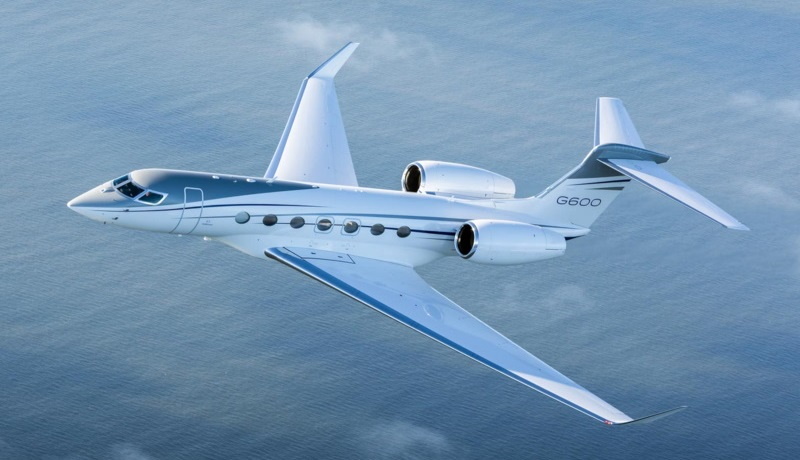
The G600 was effectively a stretched G500, being 1.1 meters (3 feet 7 inches) longer than the G500, allowing up to four passenger zones, a longer galley and a forward crew rest. There were eight passenger windows on each side. Wingspan was extended by 2.41 meters (7 feet 10 inches), while engines were uprated to PW816GA turbofans with 69.8 kN (7,110 kgp / 15,680 lbf) thrust each.
___________________________________________________________________
GULFSTREAM G600:
___________________________________________________________________
wingspan:
28.96 meters (95 feet)
length:
29.29 meters (96 feet 1 inch)
height:
7.70 meters (25 feet 3 inches)
empty equipped weight:
23,345 kilograms (51,470 pounds)
max take-off weight:
42,910 kilograms (94,600 pounds)
max cruise speed:
955 KPH (595 MPH / 515 KT)
normal cruise speed:
905 KPH (560 MPH / 490 KT)
service ceiling:
15,545 meters (51,000 feet)
range:
12,040 kilometers (7,475 miles / 6,500 NMI)
___________________________________________________________________
Cabin width and avionics were the same for both models. Initial deliveries were in 2018, with almost 200 shipped to date.
* The Gulfstream "G400" was announced in 2021, along with the G800. It was actually planned as part of a family with the G500 and G600, and appears to be a reduced-length / extended-range G500. It will be powered by twin PW812GA turbofans -- slightly smaller than the PW816GA -- and will have a maximum range of 7,775 kilometers (4,830 miles / 4,200 NMI) at Mach 0.85 with eight passengers and three crew. Five flight-test machines will be built, with initial flight scheduled for 2023.
BACK_TO_TOP* Sources include the Gulfstream website, the online Wikipedia, my set of JANE'S ALL THE WORLD'S AIRCRAFT volumes, various aircraft encyclopedias, and whatever I could scavenge online. Business jets are not over-documented.
* Illustrations credits:
Revision history: Chapter 1 and chapter 2 were released as stand-along documents in January and March 2021 respectively, both being given the revcode of "v1.0.0". The two were combined into a single document and released in November 2021 as "v2.0.0".
v2.0.0 / 01 nov 21 / Merged Gulfstream documents. v2.0.1 / 01 nov 23 / Review, update, & polish.BACK_TO_TOP
